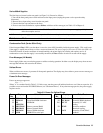
Turn-On Checkout 52
Checking the Current Function
ENERGY HAZARD. Some supplies (Series 668xA) can provide more than 240 VA at more than
2 V. If the output connections touch, severe arcing may occur resulting in burns, ignition or welding of
parts. Do not attempt to make connections while the output is live.
The tests in Table 3-2 check the basic current functions with a short connected across the power supply output. Do not
program maximum output currents unless the shorting wire is capable of handling the current (see "Supplemental
Characteristics" and Table 4-2). The AMPS display will show various readings. Ignore the VOLTS display.
Table 3-2. Checking the Current Functions (Output Terminals Shorted)
Action
Display
Explanation
Turn off the power supply and connect a #14 AWG or larger wire across the output (+) and (-) terminals. If you intend to
test at full-rated output current, use a wire or wires of sufficient size to carry the maximum current of the supply
(see "Supplemental Characteristics" in Chapter l and Table 4-2 in Chapter 4).
Turn on the supply.
Set the voltage to its maximum
value. This example assumes that
you have an 8-volt supply (see
"Performance Specifications" in
Chapter 1 for the value for your
specific supply) .
Meter mode Essentially zero outputs with Dis annunciator on.
Press
VOLT 8.000
Program output to 8 volts.
Press
AMPS 1.000
Program output to 1 ampere.
CAUTION: Be certain to observe this step with Series 668xA supplies. Start at
1 ampere before going to greater output currents.
Press
AMPS 1. 000 Dis annunciator turns off, CC annunciator turns on, and AMPS
display shows the programmed current.
Press several times
*Current decreases several milliamperes each time you press the
key.:
Press the same
number of times
*Current increases several milliamperes each time you press the
key.
*The number of milliamperes is determined by the current programming resolution of
the power supply (see "Supplemental Characteristics" in Chapter 1).
Rotate the Current control first
counterclockwise and then
clockwise
Control operates similarly to the
and keys.
The control is rate sensitive. Turning it more quickly causes a
more rapid change in current.
Press
You have enabled the overcurrent protection circuit. The circuit
then tripped because of the output short. The CC annunciator
turns off and the OCP and Prot annunciators come on. The
output current is near zero.


















